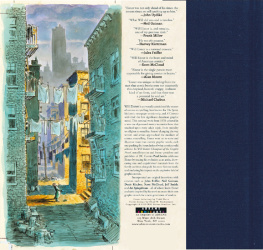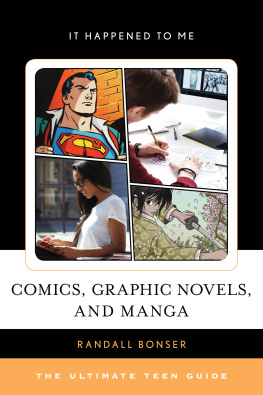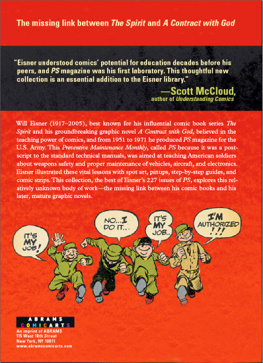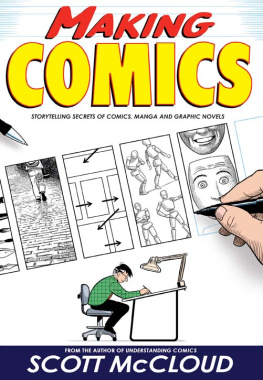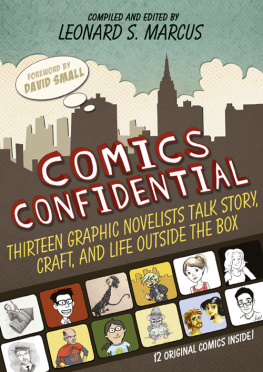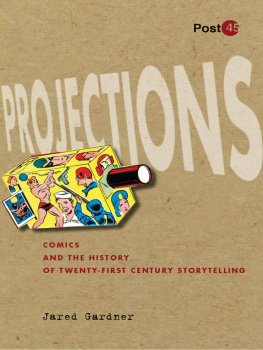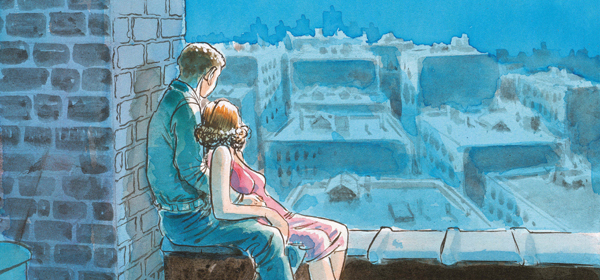
Detail, original art for the front cover of New York: The Big City, Kitchen Sink Press, 1986.

Detail, splash page from Self Portrait, The Spirit no. 101, May 3, 1942.

Above and : Will Eisner in his studio in Tamarac, Florida, May 2001, photographed by Greg Preston for his book, The Artist Within: Portraits of Cartoonists, Comic Book Artists, Animators, and Others, Dark Horse Books, 2007.


Detail, original art for the cover of A Contract With God, Kitchen Sink Press, 1985.

Detail, A Contract With God, 1978.
FOR ME, THIS IS A NEW PATH IN THE FOREST.
WILL EISNER, preface to A Contract with God and Other Tenement Stories

Detail, original art for an interior page of New York: The Big City, 1986.
A
CONTENTS
BY BRAD MELTZER
BY PAUL LEVITZ

Spot art from Eisners preface to A Contract with God and Other Tenement Stories, Baronet Press, 1978.
A
INTRODUCTION
ITS ONE OF MY GREATEST professional regrets. It was a local event. It wasnt far from my house. And here was the offer: They wanted me to come give a talk with a man named Will Eisner.
There it was: One time only. Me and Will Eisner. Together onstage (or at least together at a local library).
I passed.
Dont look at me like that. I promise I had a good reason (though for the life of me, I cant remember what it was). A conflicting event? A Little League game for my son? The more time passes, the more elaborate my excuse blooms in my memory. These days, I think I was helping rescue starving orphans from a flaming blimp that was about to Hindenburg in downtown Miami.
The point is, I didnt do the event with Eisner. Whatever was going on, I figured Id have another chance. Soon after, in January 2005, Will Eisner died. I found out he lived less than a half hour from me.
I know. You dont have to say it. Read the first sentence again: Its one of my greatest professional regrets. I mean it. It haunts me. Regularly. And yes, that story is all about me. But its also all about the legacy of Will Eisner.
To this day, the reason my regret guts me so deeply is because I was well aware of Eisners place in comic book history. In many ways, the two cant be separated. As youll see, Eisner wasnt just a participant in that history. He was a builder, a finely trained mason laying the cornerstones that became our industrys foundation.
To the general public, hes famous for giving us the term graphic novel. Let me just say it: To me, thats not Eisners legacy. These days, the term itself is more often co-opted and used to put so-called serious work up on a cultural pedestal, while ghettoizing the more mainstream comic book and super hero portion of our industry. Theres nothing gained by snobbishly ignoring ones own culture, and I truly believe Will Eisner would never stand for that. Dont forget, this is the man who would proudly sit onstage as the Eisner Awards were given out in his name. And during the first year of those awards, the big winners werent just Watchmen or the folks who pride themselves on their New Yorker covers. They were Steve Rudes Nexus, a Gumby comic, and even a Space Ghost one. Eisner stoodand still standsfor it all.
In my eyes, Eisners legacy wasnt that he was one of the first to create serious comics. Its that he was one of the first to show the world that comics should be taken seriously.
Indeed, throughout his life, he became the ambassador of exactly that. He was the one we would hold up, pointing with pride at books such as A Contract with God, praying for the one thing that had evaded comics for so long: credibility. I still remember reading A Contract with God all those years ago. I grew up in a crappy apartment building in Brooklyn. Eisners was in the Bronx. In my far-too-egotistical young eyes, that made us generational brethren. And then as I began to read, well in those pages, and in so many more, I saw his ability toActually, Ill let this book do its job and show you what Eisner really built.
Thanks to Paul Levitz, we now have a truly definitive overview of Eisners forceful and instrumental work. So as you turn the pages and things look familiar, just remember, Eisners the one who did it first. All I can say is, his commitment to the craft is the reason I get to sit here today. His work influenced me and influenced nearly every comic book creator I draw influence from.
As for my Will Eisner meeting, I learned my lesson. A few years later, I did a treasured event with artist Jerry Robinson (creator of the Joker and Robin, the Boy Wonder); got to know Joanne Siegel (widow of Superman co-creator Jerry Siegel); and have picked the brains of Stan Lee and so many other of my heroes, including the author of this book.
When I was growing up in Brooklyn, one of the comic book stores I used to go to (I found out years later) had an employee named Dan DiDio (currently the co-publisher of DC Comics). When Dan was younger, he used to go to a comics store that had an employee named Paul Levitz (the former president and publisher of DC Comics). Sometimes we have no idea just how intertwined our histories can be.
Heres the proof: Decades later, it was Paul Levitz who okayed a storyline I wrote for DiDio that eventually led to my winning what else? The Will Eisner Award (Best Single Issue 2008Justice League of America no. 11).
To this day, its the only award I keep on display. It means everything to me. Not for the win. But for who it represents and the gifts he gave us.
BRAD MELTZER
Fort Lauderdale, Florida
October 2014
Brad Meltzer is the #1 New York Times bestselling author of The Inner Circle, The Book of Fate, and seven other bestselling thrillers. He is one of a handful of authors to have books on multiple bestseller lists: nonfiction (History Decoded), advice (Heroes for My Son and Heroes for My Daughter), childrens books (I Am Amelia Earhart and I Am Abraham Lincoln), and even graphic novels (Identity Crisis and Justice League of America). He is also the host of the History Channel television show Decoded, as well as Lost History. You can find him at BradMeltzer.com and @bradmeltzer.
Next page
